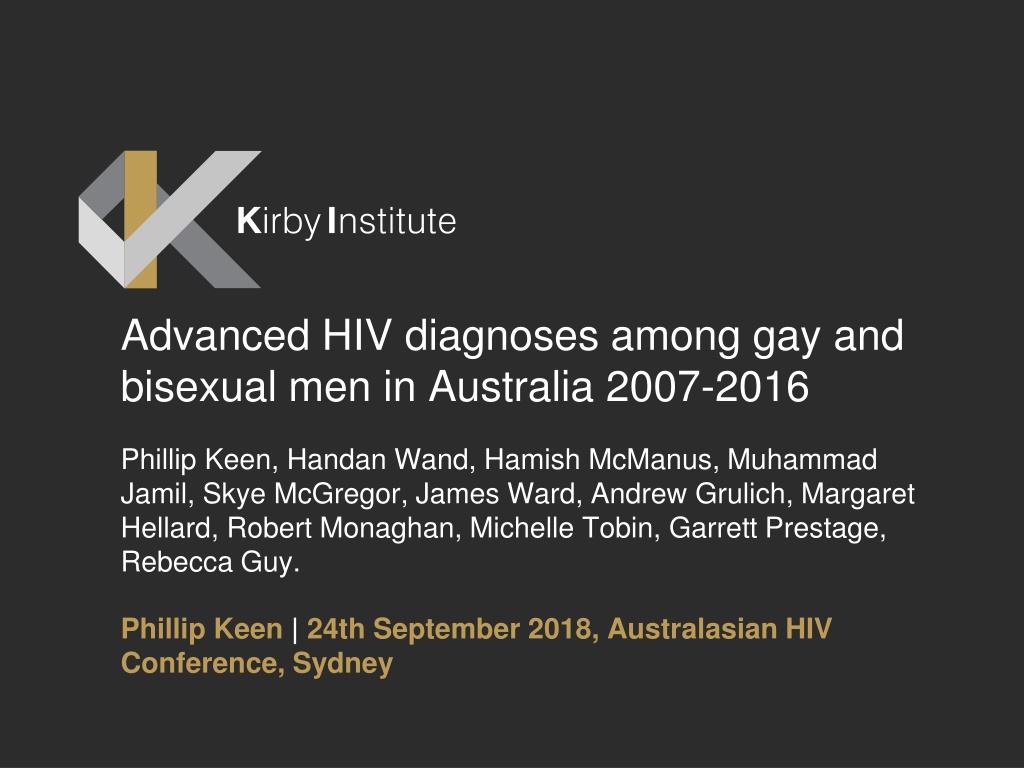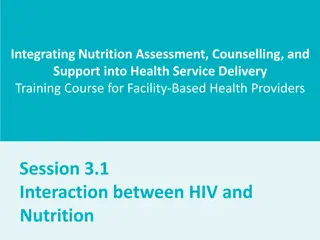Advanced HIV Diagnoses Among Gay and Bisexual Men in Australia: 2007-2016 Study Analysis
This study conducted in Australia from 2007-2016 analyzed advanced HIV diagnoses among gay and bisexual men. The research identified factors like age (30-39, 40-49, 50-59, 60+), exposure type (bisexual, MSM + IDU), and region of birth (South East Asia and North East Asia) as significant contributors to advanced HIV infections. The findings emphasize the importance of targeted interventions and early detection strategies to prevent advanced HIV diagnoses and their associated impacts on mortality and morbidity.
Download Presentation

Please find below an Image/Link to download the presentation.
The content on the website is provided AS IS for your information and personal use only. It may not be sold, licensed, or shared on other websites without obtaining consent from the author. Download presentation by click this link. If you encounter any issues during the download, it is possible that the publisher has removed the file from their server.
E N D
Presentation Transcript
Advanced HIV diagnoses among gay and bisexual men in Australia 2007-2016 Phillip Keen, Handan Wand, Hamish McManus, Muhammad Jamil, Skye McGregor, James Ward, Andrew Grulich, Margaret Hellard, Robert Monaghan, Michelle Tobin, Garrett Prestage, Rebecca Guy. Phillip Keen | 24th September 2018, Australasian HIV Conference, Sydney
Advanced HIV diagnoses among Australian GBM 2007-2016 Definitions Advanced HIV infection (CD4+ <200 cells/ l) ~8 years following seroconversion (Lodi, CID, 2011) Late HIV diagnoses (CD4+ = 200-349 cells/ l) ~4 years following seroconversion (Lodi, CID, 2011) Excludes cases with evidence of primary HIV infection (<12 months) and seroconversion illness 2
Advanced HIV diagnoses among Australian GBM 2007-2016 Late and Advanced HIV Diagnoses - Impacts Strongly linked to increased mortality and morbidity, and reduced life expectancy (Mocroft, PLOS 2013; Nakagawa, AIDS, 2012; Sabin, Stocle, HIV Medicine 2012) Higher costs to health systems(NAT, Commissioning HIV Testing Services in England 2014) People with undiagnosed HIV infections may unwittingly transmit to others 3
Advanced HIV diagnoses among Australian GBM 2007-2016 Results - Multivariate analysis Factor Advanced HIV Diagnosis Adjusted Odds Ratio 95% CI p-value Age 15-29 30-39 40-49 50-59 60+ 1 - - 1.89 3.49 5.78 8.43 1.49-2.40 2.74-4.43 4.43-7.55 6.05-11.74 <0.001 <0.001 <0.001 <0.001 HIV exposure Homosexual Bisexual MSM + IDU 1 - - 2.41 1.76 1.92-3.01 1.30-2.38 <0.001 <0.001 Region of birth Australia/Oceania South East Asia North West Europe Americas All North East Asia South Central Asia Sub-Saharan Africa Others 1 - - 2.63 0.91 1.36 1.35 0.20 1.03 0.66 2.07-3.33 0.76-1.25 0.92-2.02 0.89-2.05 0.05-0.82 0.53-1.99 0.44-1.01 <0.001 0.562 0.127 0.025 0.025 0.933 0.058
Advanced HIV diagnoses among Australian GBM 2007-2016 Conclusions Advanced HIV diagnoses among GBM are associated with a small number of factors: Age: 30-39, 40-49, 50-59, 60+ Exposure: Bisexual, MSM + IDU Region of birth: South East Asia and North East Asia Men with these characteristics account for most advanced infections among GBM 5
Advanced HIV diagnoses among Australian GBM 2007-2016 Thanks to State and territory HIV surveillance officers Handan Wand Hamish McManus Rebecca Guy Garrett Prestage Shawn Clackett























